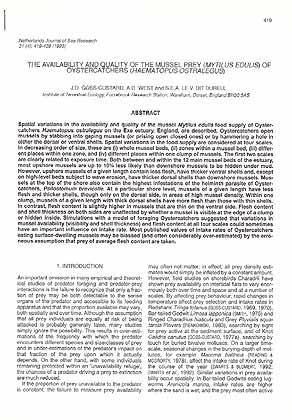goss custard west dit durell (1 Ergebnisse)
Produktart
- Alle Produktarten
- Bücher (1)
- Magazine & Zeitschriften
- Comics
- Noten
- Kunst, Grafik & Poster
- Fotografien
- Karten
-
Manuskripte &
Papierantiquitäten
Zustand
- Alle
- Neu
- Antiquarisch/Gebraucht
Einband
- alle Einbände
- Hardcover
- Softcover
Weitere Eigenschaften
- Erstausgabe
- Signiert
- Schutzumschlag
- Angebotsfoto
Land des Verkäufers
Verkäuferbewertung
-
The availability and quality of the mussel prey (Mytilus edulis) of oystercatchers (Haematopus ostralegus)
Erscheinungsdatum: 1993
Anbieter: ConchBooks, Harxheim, Deutschland
Spatial variations in the availability and quality of the mussel Mytilus edulis food supply of Oystercatchers Haematopus ostralegus on the Exe estuary, England, are described. Oystercatchers open mussels by stabbing into gaping mussels (or prising open closed ones) or by hammering a hole in either the dorsal or ventral shells. Spatial variations in the food supply are considered at four scales. In decreasing order of size, these are (i) whole mussel beds, (ii) zones within a mussel bed, (iii) different places within one zone, and (iv) different places within one clump of mussels. The first two scales are clearly related to exposure time. Both between and within the 12 main mussel beds of the estuary, most upshore mussels are up to 10% less likely than downshore mussels to be hidden under mud. However, upshore mussels of a given length contain less flesh, have thicker ventral shells and, except on high-level beds subject to wave erosion, have thicker dorsal shells than downshore mussels. Mussels at the top of the shore also contain the highest infestations of the helminth parasite of Oystercatchers, Psilostomum brevicolle. At a particular shore level, mussels of a given length have less flesh and thicker shells, though only on the dorsal side, in areas of high mussel density. Within one clump, mussels of a given length with thick dorsal shells have more flesh than those with thin shells. In contrast, flesh content is slightly higher in mussels that are thin on the ventral side. Flesh content and shell thickness on both sides are unaffected by whether a mussel is visible at the edge of a clump or hidden inside. Simulations with a model of foraging Oystercatchers suggested that variations in mussel availability (visibility and shell thickness) and flesh content at all four scales could sometimes have an important influence on intake rate. Most published values of intake rates of Oystercatchers eating surface-dwelling mussels may be biassed (and often considerably over-estimated) by the erroneous assumption that prey of average flesh content are taken. 21 pp., 11 figs, gr. 8.


